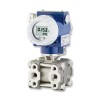It is possible to view part of the diaphragm on most pressure transducers and some which are completely exposed such as flush diaphragms are particular vulnerable to mechanical damage.
The first sign of damage may not actually be that detectable to the eye, instead it may show up as a small zero setting offset on the output signal. In some cases the damage maybe so severe that the diaphragm has completely ruptured compromising pressure containment or it is touching an internal component causing mechanical interference or an electrical short/open circuit.
Some of the signs which may point to a damaged diaphragm:
- Traces of oil leaking from the pressure port
- Decaying pressure output signal over time
- Sudden change in output signal at certain pressures
- Complete loss of output signal
- Output signal stays at fixed value when pressure changes
- Large change in zero offset reading
- Significant change in reading characteristic or accuracy over the pressure range of the device
NB – Above symptoms may also be attributed to other modes of failure.
Once a diaphragm has been damaged it is generally not possible to repair it. Some manufacturers incorporate the ability to replace a sensor module into the design on more expensive devices but for most products it is not economically viable to repair and therefore a replacement is the only option if the performance is deteriorating. Even if the performance change is acceptable the mechanical integrity of the diaphragm maybe compromised so much that a premature failure of the diaphragm is more likely to occur, shortening the service life.
A pressure transducer diaphragm is designed for many cycles of pressure in order for it to have a long service life and during the design and development phase it will be rigorously tested for mechanical integrity. A diaphragm failure, particularly at an earlier time in the service life, is more likely to be caused by an event which exceeds the specification limits of the transducer.
Some possible causes of diaphragm damage:
- Sustained over-pressure
- Cavitation from dynamic changes in liquid flow
- Pressure spikes/surges
- High frequency dynamic fatigue
- Point loading of diaphragm with screw-drivers, pens or any pointed tool
- Corrosion from incompatible media
- High ‘g’ impact
- Vibration at diaphragm resonant frequency
- Expansion due to a change in media state from a liquid to a solid e.g. water and ice
A pressure transducer diaphragm is designed to withstand much of what an industrial environment will throw at it. There are some hazards though that should be avoided to protect what is after all a sensitive measurement instrument.
Related Help Guides
- What is difference between working, burst and over pressure
- Selecting a pressure range for optimal service life and accuracy
- Protecting a pressure sensor from high pressure spikes

